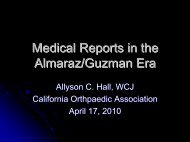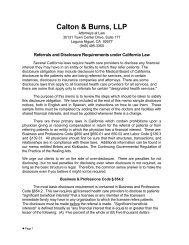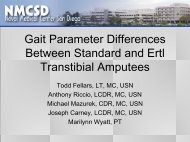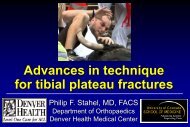Enhancing Your Practice's Revenue - California Orthopaedic ...
Enhancing Your Practice's Revenue - California Orthopaedic ...
Enhancing Your Practice's Revenue - California Orthopaedic ...
- No tags were found...
Create successful ePaper yourself
Turn your PDF publications into a flip-book with our unique Google optimized e-Paper software.
esponsibility – sets up a perfect scenario for a professionalliability lawsuit.How is the problem beingresolved around the country?The “old guard” mentality stipulated that taking callwas a responsibility, a foregone conclusion. However,as we have established, there are many factors that leadcurrent-day physicians to reject that premise. Hospitals,on the other hand face a dilemma: they must ensure, as aresult of a variety of factors, that they have an appropriatecomplement of physicians/specialists available on-call. As aresult, many have found it necessary to “compel” physiciansto participate in the call schedule.Frequently, hospital by-laws require a physician on themedical staff to participate in his or her department’s callschedule. That “stick” approach, however, seems to bediminishing. According to a recent <strong>California</strong> <strong>Orthopaedic</strong>Association (COA) study, in 2010, just 56% of surgeonssurveyed were required to take ED call as opposed to 75%responding to a 2004 survey. Interestingly, 44% of respondentsin that survey reported that by-laws existed in theirinstitutions exempting physicians from taking call after thephysician reaches a defined age threshold.Hospitals seem to have accepted the reality that they needto implement a “carrot” approach to guaranteeing that theED will have sufficient on-call coverage. In a 2007 report,the Medical Group Management Association (MGMA)found that nationally 26.7% of practices were receivingcompensation from their hospital to cover call. In the 2010COA study, 72% of physicians were receiving compensationfor taking call (up from 26% in 2000).The methodology by which compensation is implementedvaries considerably. The most frequently reportedoptions include a flat payment for taking a defined segmentof call, regardless of whether or not a physician must comein to provide care. Some institutions have a stratified systemthat additionally compensates for each instance that aphysician actually does come in to see a patient in the ED.Higher payments for taking weekend and holiday call arealso common.Many hospitals have resisted the “blank check” approachof paying for physicians to simply take call. In many waysthis is understandable. Frequently the CEO/CFO dislikesthe concept of paying a doctor and potentially gettingnothing in return in terms of procedures or hospital admissions.Secondly, the fear of an “entitlement mentality”developing on doctors’ part worries many hospital administrators;they worry that once a precedent is established,it will be very difficult to reverse. In response to theseconcerns, some institutions have adopted a system wherebyphysicians are paid for the cases that they take care of whileon call. Typically, this applies to uncompensated/uninsuredpatients. In the COA survey, 33% of respondents reportedthat their hospital guarantees payment for uninsured patients.The MGMA publishes a report entitled “Medical Directorshipand On-Call Compensation Survey” on an annualbasis. The 2010 Report (based on 2009 data) is currentlyavailable for purchase. The report provides a wealth ofinformation, including detailed descriptions of the typesand rates of compensation arrangements based on specialtyand geographic region. [Note: AAOS cannot advise membersregarding precise compensation amounts of any kind,including compensation for on-call.]Case Study: A Three-pronged SolutionThe orthopaedists at “Silver Star Community Hospital”(renamed to protect the innocent) had been tryingunsuccessfully to convince the hospital that compensationfor on-call coverage was appropriate and necessary.Needless to say, the relationship between the doctors andthe hospital became increasingly strained. For a long timethe hospital was able to exercise the power of the by-lawsand require that an orthopaedic surgeon be available oncall,satisfying trauma center requirements.However, as the newly appointed CEO studied the situation,and took into consideration national trends on thistopic, he quickly realized that a new approach was necessary.Various options, described above in the “How is theproblem being resolved” section, were considered. For themost part, the surgeons were keenly interested in a dailystipend for taking call; however that option was the leastappealing to the hospital administration. A key componentin the ultimate solution was the willingness of physicianleadership and the hospital CEO to remain open todiscussion of alternative arrangements. The resolution thatbecame a “win-win” for both sides included the following:1. The hospital established a system to be the insurer oflast resort for uninsured patients. The current yearCMS conversion factor was the accepted standard. Thisensured that physicians who took care of uninsuredpatients while on mandatory call rotation, weren’teffectively also paying for the privilege of being on-callout of their own pockets.2. The hospital hired a Physician Assistant (PA) dedicatedto the <strong>Orthopaedic</strong>s Department. The PA’s primaryresponsibility was to assist with the care of uninsuredpatients including staffing a hospital-based fractureclinic for ER follow-ups. This immediately relievedthe burden on the PAs who worked for the individualsurgeons and who were previously providing suchservices for free (i.e., at the expense of their employingphysicians).3. Last, the hospital agreed to a daily stipend for call© 2011 American Academy of <strong>Orthopaedic</strong> Surgeons27
















